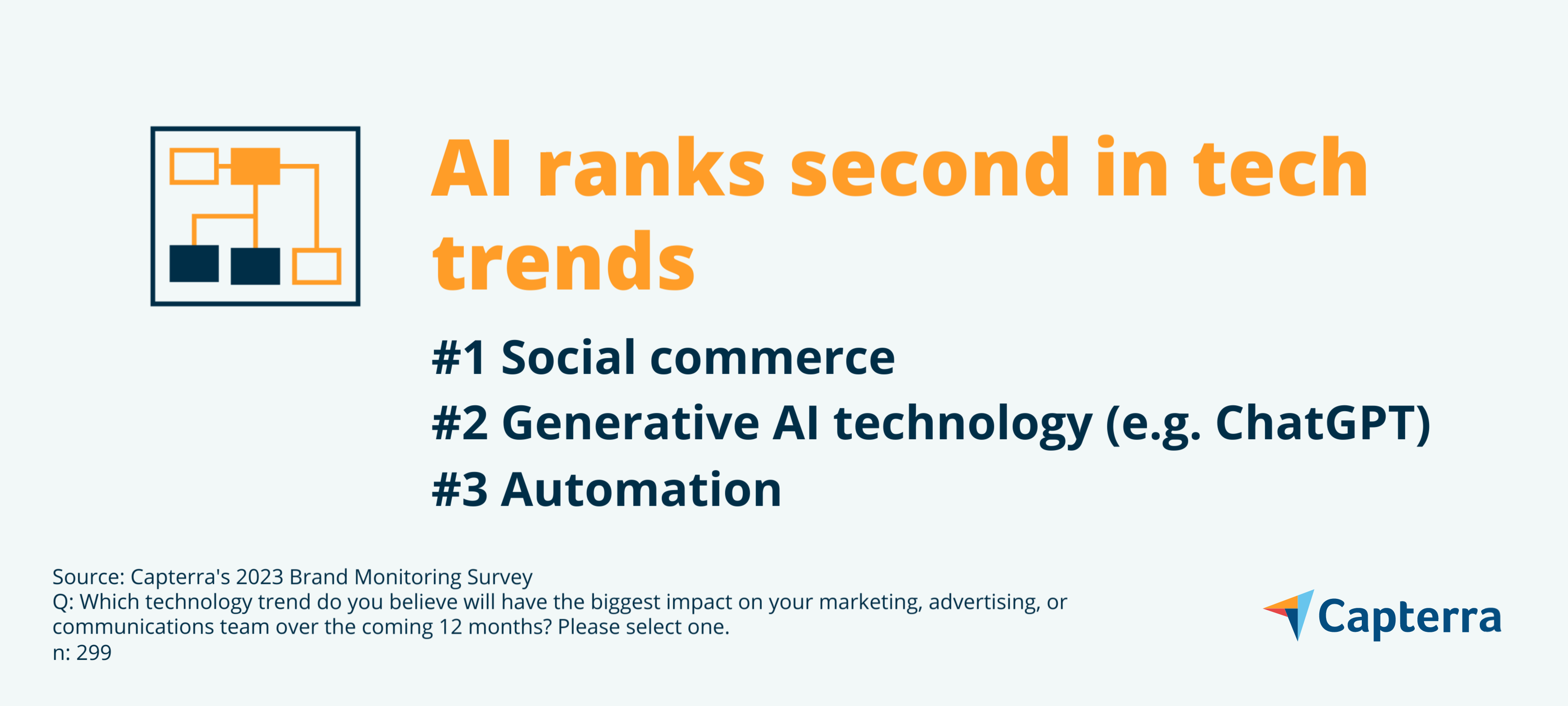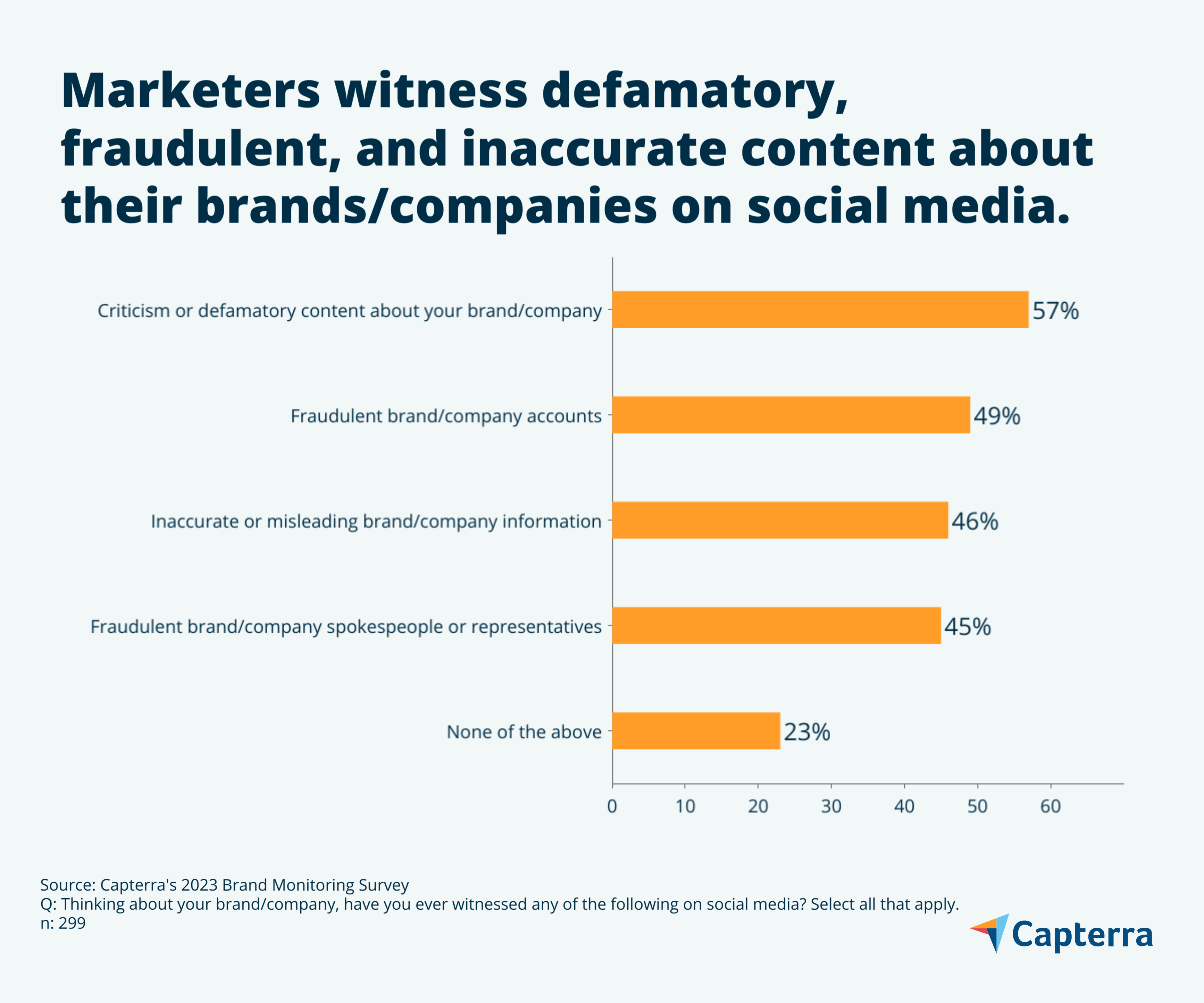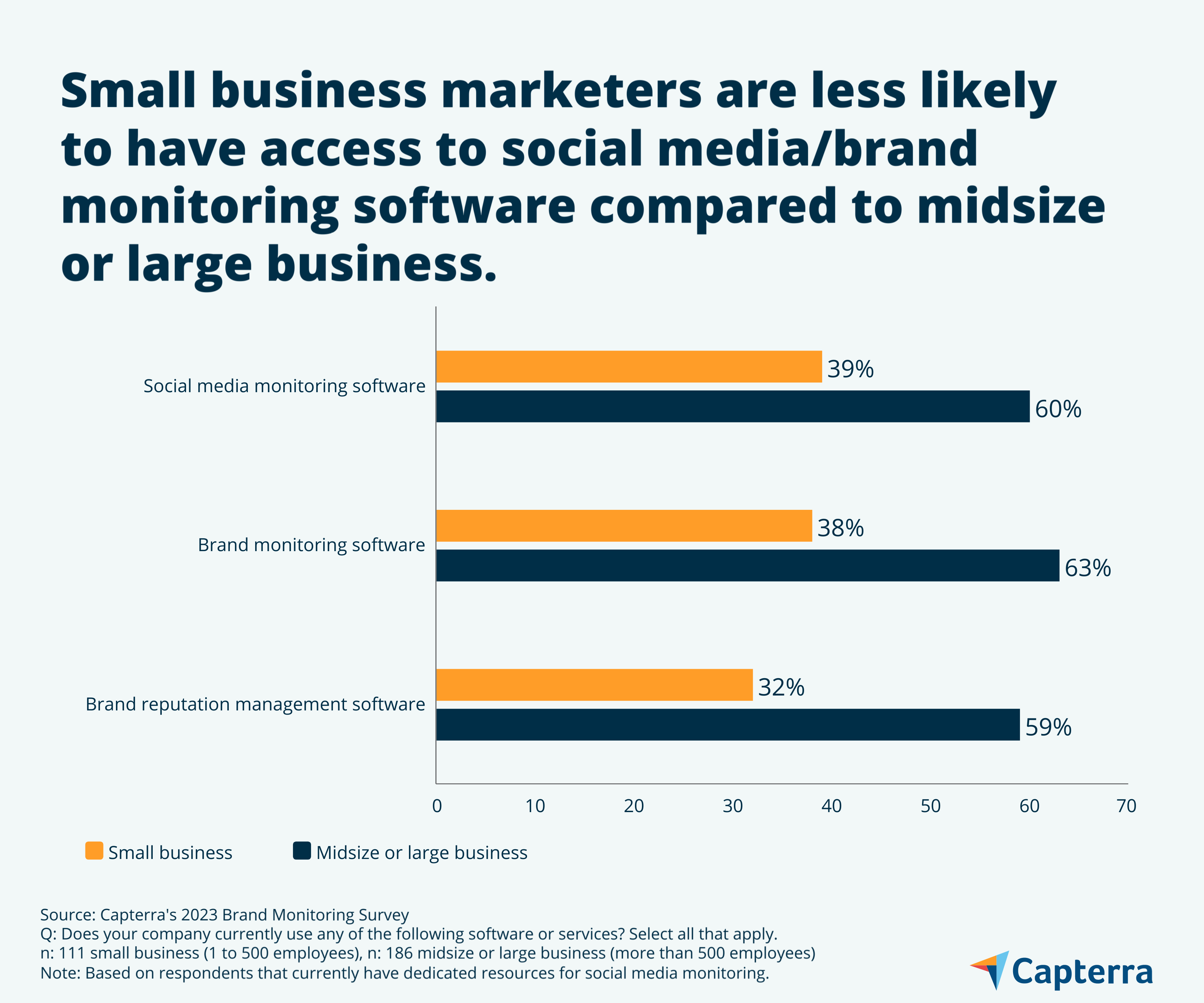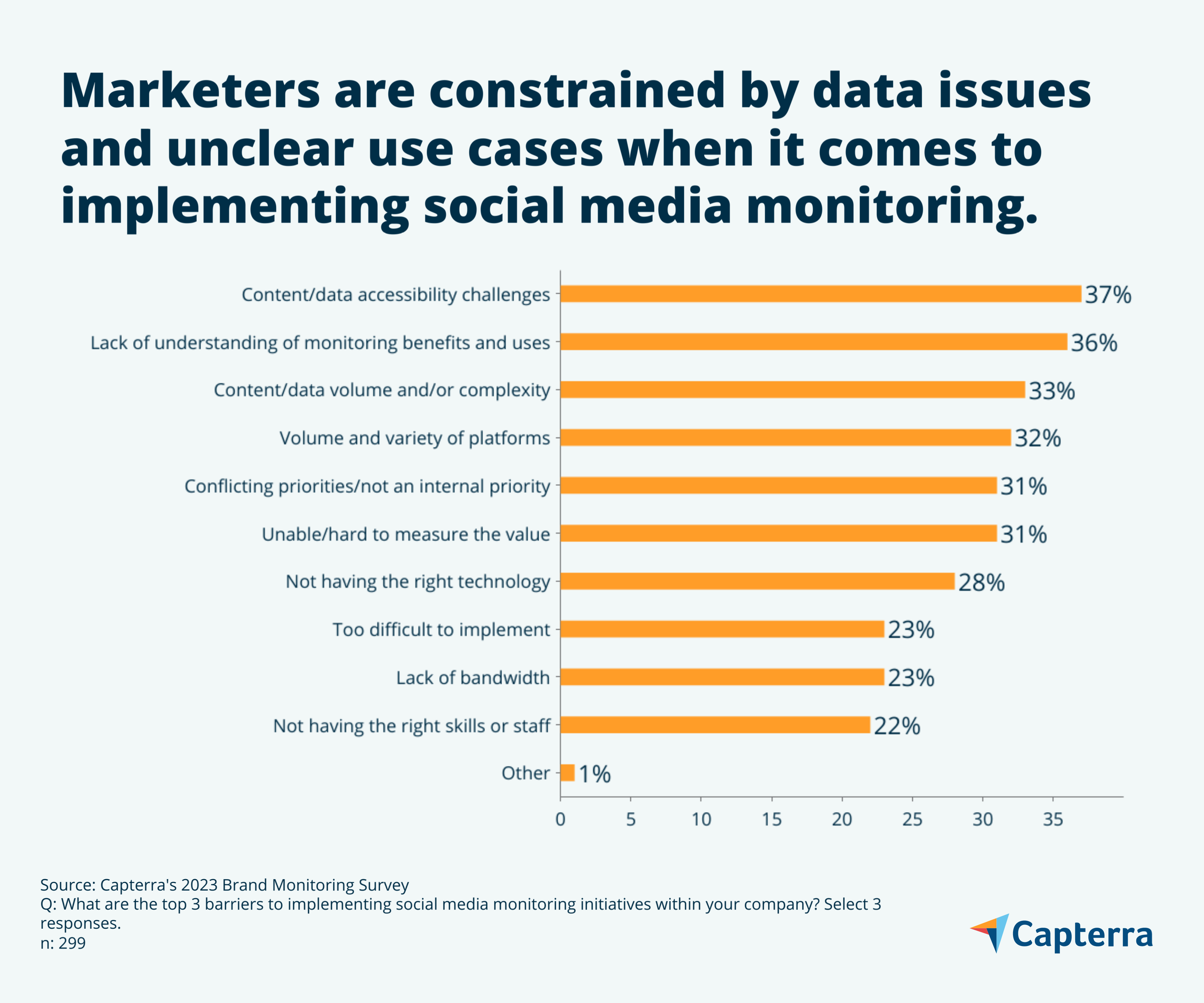Learn how to fight back against fraudulent content with clear policies, software, and upskilling.
Generative artificial intelligence (AI) tools like ChatGPT have entered the scene, making it easier than ever for anyone to create content about your brand. But for marketers, these free or low-cost tools mean an escalation of potentially hazardous fake or misleading content on social media. In fact, Gartner predicts that by 2027, 80% of marketers will establish a dedicated content authenticity function to combat such issues[1].
According to Capterra’s 2023 Brand Monitoring Survey, 88% of marketing, advertising, or communications professionals surveyed believe that the use of AI among consumers will be widespread over the next 12 months*.

To keep your brand’s reputation safe in the new era of AI, you need to boost your brand and social media monitoring efforts. The following research reveals how marketers are currently monitoring and responding to social toxicity or authenticity issues. We’ll also provide tips on how to implement successful brand and social media monitoring strategies at your company.
/ Key findings
Prepare for an increased need for social media and brand monitoring: 57% of marketers say they have witnessed criticism or defamatory content about their brand or company on social media. Nearly half (49%) have run into a fraudulent brand or company account.
Small businesses are less equipped to respond to social media content issues: Small-business marketers are more likely to disagree (17%) that their company is prepared to respond to fraudulent or inauthentic content on social media compared to midsize or large business marketers (9%).
Small businesses lack software to combat fake content: Small-business marketers are less likely to have access to social media (39%) and brand monitoring software (38%) compared to midsize or large businesses (60% have social media monitoring software and 63% have brand monitoring software).
Data challenges are a barrier to implementing social media monitoring: 37% of marketers say that data accessibility challenges continue to get in the way of these initiatives.
Marketers believe fraudulent or inauthentic content will get worse
Thanks to digital media fragmentation and a booming creator economy, social media and brand monitoring are already a necessary part of the marketing and advertising world—even before adding generative AI to the mix.
A growing number of social platforms and an increase in user-generated contentNearly three in five marketers (59%) believe that fraudulent or inauthentic content on social media will get worse over the next 12 months:

And while 80% of marketers indicate that managing or monitoring their brand reputation is one of their social media goals, 38% say that they are not doing well responding to or identifying inaccurate or misleading brand or company information.
AI and other tech advancements will play a role in both causing and solving content authenticity issues, as there's software and services available to help detect and address content authenticity issues. Our survey found that 95% of marketers believe that AI technology will make their day-to-day job responsibilities better.
However, the fast-paced adoption of AI technology has led 67% of marketers to believe that it’s difficult to keep up with the rate of change in their industries. Furthermore, 93% of marketers say that even with AI technology or tools, brand monitoring requires human analysis of data.
Technology alone will not suffice as a solution. Companies need dedicated staff and the expertise to identify, escalate, and respond to content issues on social media platforms.
Thinking about hiring a social media marketing agency to help your business manage and monitor social media content? Browse our list of top social media marketing agencies and learn more about their services in Capterra’s hiring guide.
Small businesses are less likely to use social media monitoring software
Small businesses (those with one to 500 employees) often have limited social media or brand monitoring resources compared to midsize or larger businesses, potentially putting their brand’s safety at risk.
Our survey shows that 73% of total marketers say their company has dedicated resources (e.g., budget, staff, software, task force, etc.) for social media monitoring. However only 58% of small businesses have such resources compared to 81% of midsize or large businesses. Additionally, only 42% of small businesses plan to acquire social media monitoring resources in the next 12 months, indicating that this issue may continue to persist in the future.
Small businesses follow a similar pattern in their company’s use of social or brand monitoring software:

Small-business marketers are less prepared to respond to social media misinformation and attacks compared to midsize or large businesses. Therefore, it’s important that these organizations work with their leaders to prioritize social media and brand monitoring resources. In order to address how your company monitors social media data, invest seriously in the right tools. Selection comes down to your company’s needs and how you will be analyzing the data.
A good place to start is to take stock of the social monitoring or analytics tools your company might already be using (if any). Ask if they are being used to their full capabilities or if there is anyone in your department who has specialized experience. Software with reputation management or sentiment analysis features is especially helpful to identify potentially damaging content.
Data challenges are the greatest barrier to implementing social media monitoring—fight back with a clear policy and upskilling
Challenges around data accessibility, volume, and complexity are hindering companies of all sizes from implementing social media monitoring initiatives. In fact, these challenges outweigh not having the staff, skills, or time:

According to another recent Capterra survey, 42% of marketers report that it is extremely or very challenging to share marketing data at their company**. Boosting data-centric functions and accessibility can improve your company’s social media and brand monitoring capabilities. One way to achieve this is by having a data management policy—essentially documentation for handling, storing, processing, and managing data across a business. Policies will define the process and responsible parties for collecting or analyzing social media data, providing clarity and a standard for all employees.
Upskilling your team on data tools and techniques will allow your marketers to not only gain access to the data they need, but to get the most out of it. This can include training on specific social media monitoring tools, how to monitor or track user-generated content that references their brand or company, as well as more general training on data literacy or interpretation.
88% of companies with social media monitoring resources say they are of high value to their business
Thirty-six percent of marketers say that lack of understanding of monitoring benefits and uses is a top barrier to implementing initiatives at their company.
The perks of social media and brand monitoring extend beyond keeping your brand safe. Respondents that engage in social media monitoring say the top benefits are increasing sales (39%), increasing engagement opportunities (33%), and helping to manage interactions with customers (32%).
Social media and brand monitoring can be challenging for companies because of newly adopted generative AI-technology, the volume and complexity of data marketers must keep track of, and the fast-paced nature of social media in general. However, your company can address these challenges through the right data practices, monitoring tools and training, and by clearly communicating the use cases and benefits of social media and brand monitoring practices.

